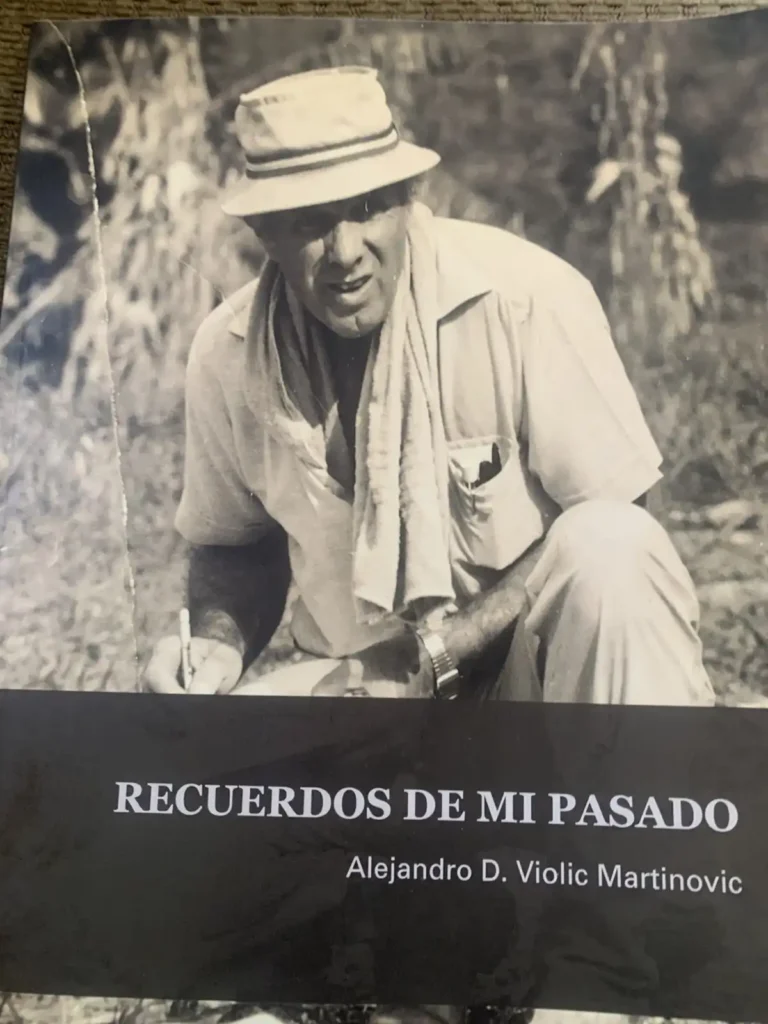99-year-old Chilean scientist is a living legend in plant genetics, and here’s his story.
At the age of 99, Dr. Alejandro Violic is a prominent figure in the field of plant genetics, whose life and work have transpired in parallel to the evolution of this science over the last century. His sharp mind and physical vigor are astonishing, making him easily look 25 years younger. In his relentless pursuit of excellence, Violic’s life has been marked by his dedication to the agricultural sector, especially in training younger generations of geneticists and agronomists in the art and science of plant breeding and production techniques.
Alejandro’s parents are Croatian immigrants who came to Chile around 1900 from the Kingdom of Yugoslavia (Croatia became a sovereign state in 1991). He was born on the same date as his father and paternal grandfather, the 14th of February, but in 1925. He spent his youth living in the southernmost tip of Chile (and of the world), in the city formerly known as Magallanes, now Punta Arenas. Here, he met his wife of now 74 years, Neva Goic, also the daughter of Croatians, and who, like Dr. Violic, is blessed with wonderful physical and mental health for her 98 years of age.
Younger generations find it hard to imagine a world without the internet or mobile phones. But for Alejandro Violic, music came from phonographs, antibiotics did not exist to treat sicknesses, and he studied agronomy when the laws of Mendel had been re-discovered about 45 years earlier. He began his career when the field of plant breeding was taking its first steps. As technology advanced, Dr. Violic kept up with developments in his field, adapting to new methods and contributing with his vast knowledge to the evolution of plant breeding, particularly in maize.
Seed World LATAM recently had the great pleasure of meeting face-to-face with Alejandro Violic and his wife, Neva, to discuss his role and the impact he has had in agronomy and plant breeding.
SW LATAM: You started your career studying agronomy at the Catholic University of Chile in the 1940s. How did you decide to pursue this discipline? Tell us about your academic history to become one of the first Chileans with a Ph.D. in plant genetics.
Alejandro: When I was 18, I was eager to study medicine. I passed the exams to enter medical school at either the University of Chile or the Catholic University in Santiago. Given the remoteness of Punta Arenas, in the extreme south of Chile, traveling to Santiago took at least 10 days by boat and train. When I arrived, I received the bad news that enrolments to medical school had closed the day before my arrival. As fate would have it, I opted for agronomy at the Catholic University of Chile, as it was another biological discipline.
After finishing my degree and working with my father in Magallanes for a few years, I returned to central Chile to participate in a groundbreaking agricultural development program funded by the Inter-American Institute for Cooperation on Agriculture (IICA) of the US Department of Agriculture. Launched in 1954, it was known as Plan Chillán. The program covered three important provinces in south-central Chile. One of its objectives was the development and introduction of hybrid maize in the region.
In 1956, the IICA offered me a postgraduate scholarship to study for a year at the University of Minnesota, which at that time was one of the most prestigious institutions in genetic improvement of cereals, especially maize. In a limited time of 12 months, I obtained the credits corresponding to an M.Sc. in genetics.
Among my fellow students were Frank Rembley, who would become the world-renowned president of Pioneer, one of the largest seed producers in the world, and several geneticists and pathologists, such as Dr. Elmer Johnson, with whom I worked years later at the International Maize and Wheat Improvement Center (CIMMYT) in Mexico.
Upon returning to work at the IICA in Chile in 1957, I was promoted to Head of Agricultural Research and appointed Professor of Genetics at the newly formed School of Agronomy of the University of Concepción.
In 1960, the director of the Rockefeller Foundation in Chile, Dr. Joseph Rupert, offered me a scholarship to pursue a Ph.D. at the U. of Minnesota. In 1963, I obtained my Doctorate degree in Plant Genetics, specifically in maize breeding. During my three years at the university, I was a fellow student with some historically remarkable people, such as Elmer Johnson, who developed the first varieties of lowland corn, and the world-famous Dr. Norman Borlaug, who saved millions of people from starvation and won the Nobel Peace Prize in 1970. They collaborated in the creation of the International Maize and Wheat Improvement Center (CIMMYT), where I began working in 1971 for two decades.

SW LATAM: What are some of the highlights of your career?
Alejandro: One was my involvement in the early development of maize hybrids in Chile. When I joined the Chillan Plan, I applied the teachings I received from Dr. Hernán Gacitúa and Agronomist Luis Hevia, both from the Research Department of the Chilean Ministry of Agriculture, who developed the first Chilean corn hybrids: MA1 and MA2, which marked a before and after in maize production in Chile.
However, my role as senior research staff at CIMMYT in Mexico was more significant. Here, I collaborated in the development of varieties of maize for the tropics in almost 100 countries, as well as the improvement of crop management technologies for this cereal.
SW LATAM: Of all your career achievements, what do you feel you leave as a legacy of your scientific work?
Alejandro: I don’t think I can claim any great legacy personally because what I did could have been done by someone else. But I do leave a testament of my work because I wrote hundreds of thousands of words during my life, in research, training manuals, study guides for university courses, and my complete biography, where I tell all the curious and shocking things that have happened during my life and that I was able to remember at the age of 93.
I’d say that the most important legacy I leave is my work in education. I feel that the remarkable importance of education is its multiplicative effect, because of its long-term impact. For 20 years at CIMMYT, I directed and participated in the training of about 1,000 professionals in Mexico, led by visiting scientists under the modality of in-service training, and almost as many in other countries of Central America, the Caribbean and South America. In many cases, I not only designed the curricula for these courses, but also sought funding from organizations such as FAO, WHO, and the World Bank to carry them out.

Editor’s note:
In addition to his outstanding work in research and training, Dr. Violic has played an active role in various trade and scientific organizations, such as the Chilean Association of Agronomists and the Chilean Academy of Agronomic Sciences. His dedication and achievements have earned him numerous awards and distinctions, including the “Espiga de Oro” Award and the “Carlos Porter” Award from the Chilean Association of Agronomists.
Throughout his life, Violic has witnessed revolutionary advances in the field of plant breeding, from the early development of maize hybrids to new gene editing technologies such as CRISPR. His legacy will live on as an inspiration to future generations of agricultural scientists. We at Seed World Group would like to give Dr. Alejandro Violic a standing ovation and applaud his dedication and perseverance in the world of science, genetics, agriculture, and especially what brings us here: the world of seeds.
Career Timeline
- M.Sc. (1956-57) and Ph.D. (1960-1963), both in Plant Genetics, at the University of Minnesota (USA).
- Head of Agricultural Research, Plan Chillán (1953-1960). Head of the Maize Programme, INIA (1963-1971).
- Researcher (Senior International Research Staff) at the Centro de Mejoramiento de Maíz y Trigo (CIMMYT), based in Mexico City (1971-1990) and work missions mainly related to the training of national agronomists in integrated research methods in maize breeding and production in more than 50 countries, including all of Latin America, Central America, and many countries in Asia, Africa and the Caribbean.
- Numerous publications on topics of his speciality.
- International advisor to CIMMYT, based in Chile, for CIMMYT programmes in Brazil, Argentina and African countries (1990-2000).
- Professor of Plant Breeding (Agronomy, U. de Concepción (1967-1971), Professor of Applied Statistics at Universities: UNICYT (1993-1996) and U. Mayor (2002-2012).
- Visiting Professor at the Faculty of Agronomy, University of Chile, Councillor of the Chilean College of Agronomists (1995-1997) and current member of the Ethics Committee.
- Consultant/Advisor in projects for IICA, IFAD, FAO, AID, EMBRAPA, INTA, IDB (1990-2005).
- Executive Secretary of the Council of Deans of Universities of the Council of Rectors of Chile (1996-2007).
- Member of the College of Agronomists and the Agronomic Society of Chile.
- Member of the American Society of Agronomy (ASA, USA) since 1972.
- Scientific Advisor to the International Foundation for Science (IFS), Stockholm, since 1974.
- Editor of the Revista del Ingeniero Agrónomo of the Colegio de la Orden and Technical Consultant of the journal (ISI indexed, AGRIS) Ciencia e Investigación Agraria, of the Faculty of Agronomy of the PUC.
- Carlos Porter” Award for Scientific Activity (1994).
- Espiga de Oro” Award (1994), both conferred by the Chilean College of Agronomists.
- Co-founder and executive secretary of the Chilean Academy of Agronomic Sciences.
- Academia Prize 2014, awarded by the Chilean Academy of Agronomic Sciences.












